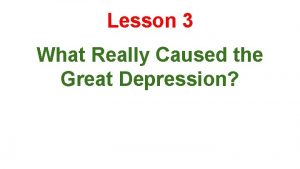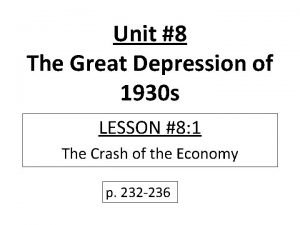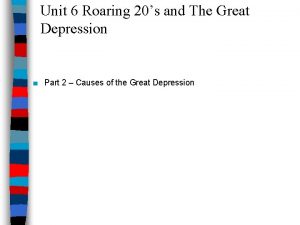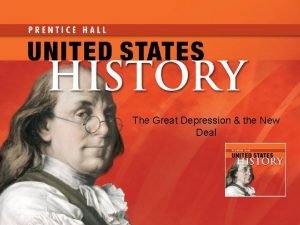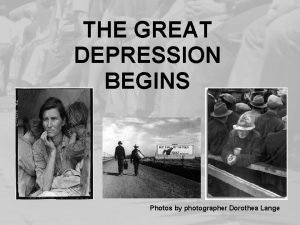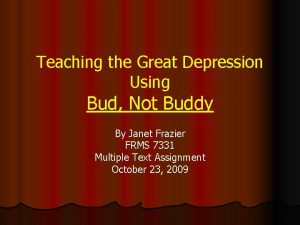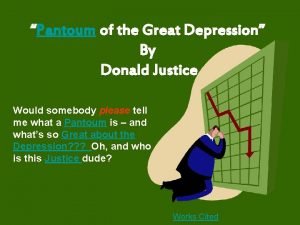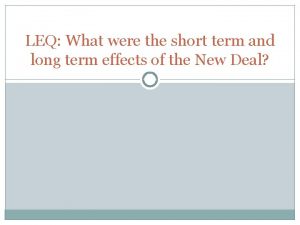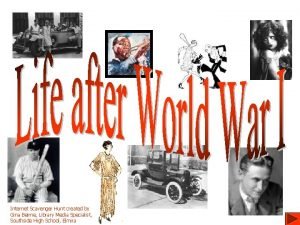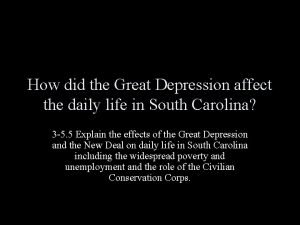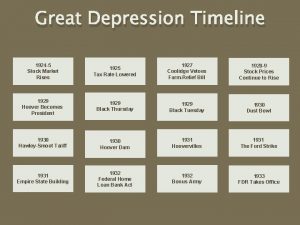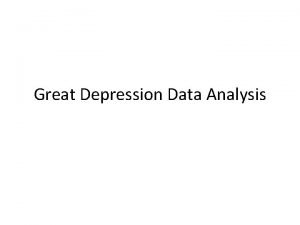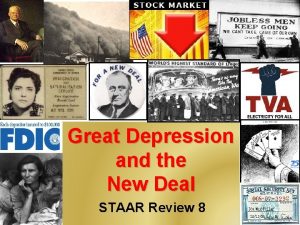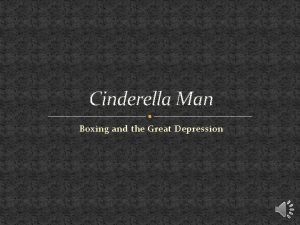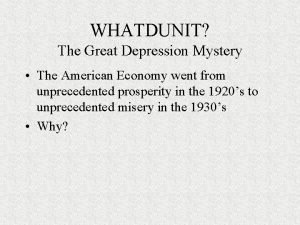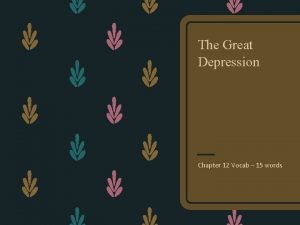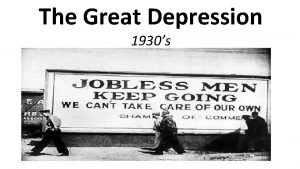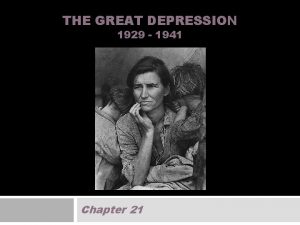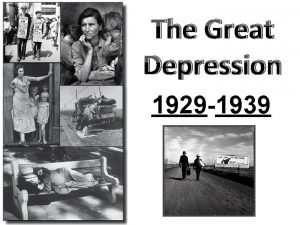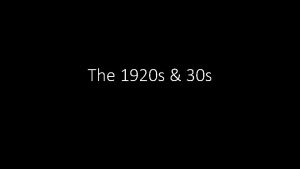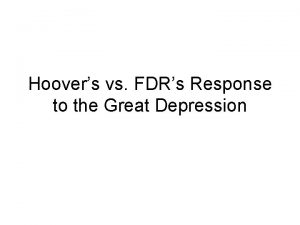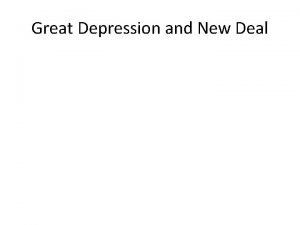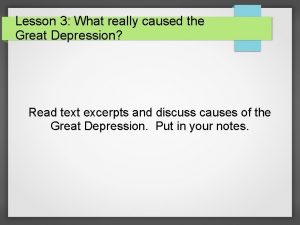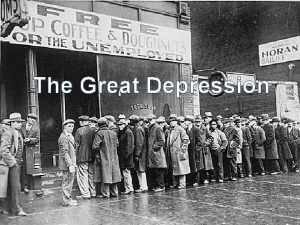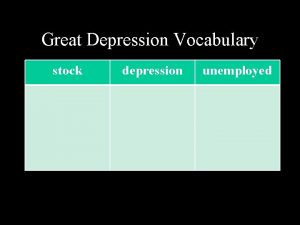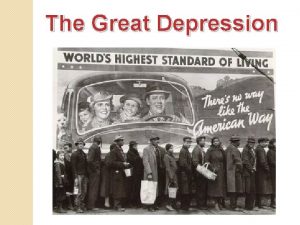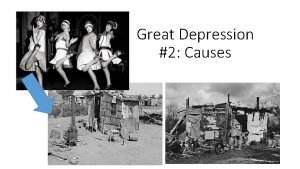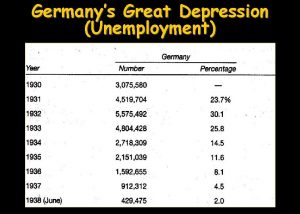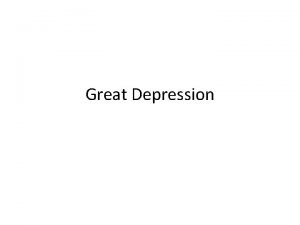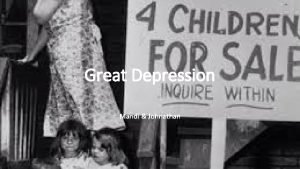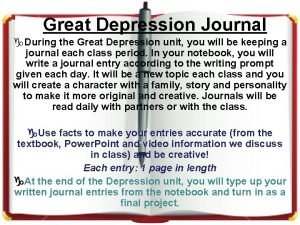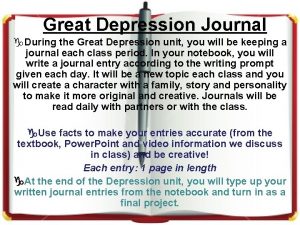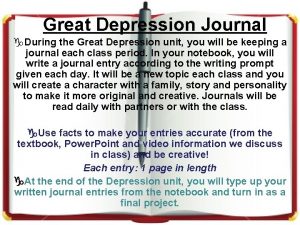Lesson 3 What Really Caused the Great Depression



































- Slides: 35

Lesson 3 What Really Caused the Great Depression?

Understanding the Great Depression 1. You are going to participate in activities to help you better understand causes of the Great Depression. 2. The first activity is a budget activity in which you will take roles as construction workers, railroad workers, farmers and teachers in 1928 and again in 1933.

Group Assignment Instructions 1. Two groups will be the farmers, two groups the teachers, two groups the construction workers, and two groups the railroad workers. 1. Each person in the group will receive a budget sheet and a scenario card.

Instructions 1. Read the directions at the top of the page 2. Complete the columns on the budget sheet in 1928. 3. When you are finish, the students with the budget card read the card to the group. 4. Complete the columns for 1933 5. Answer the questions that follow the table.

Discussion Questions 1. In 1933, when your income decreased, why did the percentage of your income spent on housing and perhaps other items increase? Answer Because income decreased, even if the dollar amount spent on a category remained constant, the percentage of income spent on that category increased

Discussion Questions cont. ● Raise your hand if your group spent the same dollar amount on food in 1928 as you did in 1933. ● What tradeoffs did you make in order to feed yourself and/or family? What did you give up?

Discussion Questions cont. ● How would these spending decision affect the economy? Answer Reduce overall spending on goods and services

Discussion Questions cont. ● Although in your role, you retained your job, one in every four (or 25%) of the workforce was unemployed. What effect did this have on spending? Answer decrease spending

Discussion Questions cont. ● If you were unemployed, what choices might you have had to make? Answer stopping house payments or selling farmland equipment

Discussion Questions cont. ● If you had additional family members come to live with you in 1933, what happened to the income person--per capita income--for your family? Answer It decreased

Information After Activity 1. What happened to you in your groups was happening to people across the country during the Great Depression. 2. The country experienced deflation, which is the decline in the average price level. 3. During the Great Depression, the prices of goods and services decreased by nearly 30 percent.

Information cont. 4. At first, deflation might seem like a good thing, but as our activity showed, with lower prices, business such as textile mills, railroads, farmers, car manufacturers and others earned less revenue.

Information cont. 5. With less revenue, business could not afford to pay people as much and/or employ as many people. 6. In the Great Depression, the economy suffered unemployment as high as 25 percent, and wages fell.

Information cont. 7. As prices decreased, business revenues decreased, wages decreased and unemployment increased. 8. When people were earning less or were unemployed and were not earning any income, they bought fewer goods and services. As a result, businesses earned even less revenue.

Information cont. 9. With wages decreasing and unemployment increasing, borrowers were not able to repay loans. 10. Loan defaults and bankruptcies followed, which produced more banks failures and further declines in output, prices and employment.

Pre-activity Notes 1. In the budget activity, people had lost their savings because banks in the community failed. 2. You will participate in role-playing to help you understand what bank failures and panics are.

Deposits, Loans, and Reserves 1. Banks take in deposits 2. Bank reserves are the amount of deposit NOT LOANED out by a bank. 3. A bank’s reserves can be calculated by subtracting a bank’s total loans from its total deposits. 4. Community bank has $6, 500 in reserves

Deposits, Loans, and Reserves 5. The United States, along with most of rest of the world, has a fractional reserve banking system. 6. This means that banks take in deposits and lend most of the money that they take in. 7. The banks keeps only a fraction of deposits on reserve.

Deposits, Loans, and Reserves 8. People who borrow money from banks use the money to buy houses, cars or other items. 9. The also use the money to start businesses, remodel their homes, go to college and so on. 10. The money loaned out is spent almost immediately by borrowers to pay for

Deposits, Loans, and Reserves 11. Because only a small fraction of the bank’s customers’ deposits are kept on reserves, not everyone can get all of their money out the bank in cash on the same day. 12. This is generally not considered a problem because, under normal conditions, all of the banks’ customers do not wish to withdraw all of their funds at the same time.

Activity # 2 1. Now you will take the role of individuals living during the 1930 s. 2. The community that you live in has 3 banks. 3. You will be given a Banking Simulation Card. 4. The 3 students who are bankers will sit at the front facing the class behind their bank’s name.

After Activity Questions 1. How many of you made deposits in your bank accounts? 2. How many of you made loans payments to your bank? 3. How many of you were unable to make loan payments? 4. How many of you want to withdraw money from your bank? 5. Did anyone have any problem? 6. With which bank did you have your account?

Feedback 1. People were withdrawing money from their banks--more money than the banks had in reserves. 2. Banks failures occur when banks are unable to meet depositors’ demands for their money.

3. When many depositors run into a bank at the same time to get their money out, it is called a “bank run. ” 4. When a bank run begins at one bank and spread to other banks, causing people to lose confidence in banks, it is called a bank panic. 5. Bank panics cause more bank failures, and the cycle continues.

Money Supply (Stock) 1. As people remove money from the banking system, the money supply shrinks. 2. The shrinking money supply means that people and businesses are able to borrow less from banks. 3. People buy fewer goods.

Money Supply (Stock) 4. Businesses sell fewer goods and services because people have less to spend. 5. Prices decline. 6. Business revenues decline. 7. Businesses are able to buy fewer supplies and equipment.

Money Supply (Stock) 8. Businesses are unable to employ as many workers, they must pay workers less or a combination of both. 9. Workers who are paid less or lose their jobs may buy fewer goods and services and may be unable to repay bank loans.

Money Supply (Stock) 10. More banks fail; so, the economy’s supply or money and credit shrinks. This causes a decline in business revenues, which leads to more unemployment and/or decreases in wages.

Comprehension Check One loose leaf paper, answer the following questions. Submit upon exit 1. What is a bank failure? 2. What is a bank run? 3. What is bank panic? 4. How did bank panic contribute to the collapse of the nation’s banking system and a reduction in the money stock?

Concluding Lesson 3 ● As the class finishes its discussion of the causes of the Great Depression, we are going to do a final scenario of the all the elements that contributed to the event.

Bank of the United States ● This was a large commercial bank that failed in 1930. Because of its name, people thought it was associated with the government. As a result, people in the United States as well as in other countries were frightened by its failure, which led to bank panics.

Stock Market Crash ● In 1929, the stock market crashed. This destroyed wealth and caused people to question whether or not the economy was strong. With the questioning came uncertainty. When people are uncertain about the economy, they tend to spend less.

Smoot-Hawley Tariff of 1930 ● The Smoot-Hawley Tariff was imposed in 1930. Along with other protectionist policies it caused the prices of imported goods to increase.

Outflow of Gold from the U. S Banking System ● In the 1930 s, the United States was on the gold standard. This means that the U. S. government would exchange dollars for gold at a fixed price.

Bank Panics and Suspensions ● Bank panics were the main reason that explained why the money stock fell during the Great Depression. The failure of the Bank of the United States, the failure of other banks and the suspension of operations by nearly 7, 000 banks created bank panics.
 Hardship and suffering lesson 2
Hardship and suffering lesson 2 Lesson 3 effects of the great depression
Lesson 3 effects of the great depression What caused the great schism of 1378
What caused the great schism of 1378 Aaa new deal logo
Aaa new deal logo Rarig great depression
Rarig great depression Great depression
Great depression Tennessee valley authority
Tennessee valley authority Foreclosure great depression
Foreclosure great depression Five effects of the great depression
Five effects of the great depression Five effects of the great depression
Five effects of the great depression How did the great depression impact the world
How did the great depression impact the world Great depression ap world history definition
Great depression ap world history definition Bud not buddy great depression
Bud not buddy great depression Pantoum of the great depression
Pantoum of the great depression The great depression summary
The great depression summary What is deflation
What is deflation Okies great depression
Okies great depression The great depression leq
The great depression leq Roaring twenties scavenger hunt answers
Roaring twenties scavenger hunt answers How did the great depression affect south carolina
How did the great depression affect south carolina Great depression timeline
Great depression timeline Great depression causes
Great depression causes Mexican repatriation apush
Mexican repatriation apush Hoovervilles
Hoovervilles Birth rate during the great depression
Birth rate during the great depression Overspeculation great depression
Overspeculation great depression Great depression vocab
Great depression vocab Chapter 14 the great depression begins vocabulary
Chapter 14 the great depression begins vocabulary Great depression bank runs
Great depression bank runs Http://www.history.com/topics/great-depression
Http://www.history.com/topics/great-depression Black tuesday great depression
Black tuesday great depression Hawley-smoot tariff great depression
Hawley-smoot tariff great depression Political cartoon stock market crash 1929
Political cartoon stock market crash 1929 Hoover v. fdr responses to the great depression
Hoover v. fdr responses to the great depression Hoovervilles great depression
Hoovervilles great depression Laissez faire great depression
Laissez faire great depression

